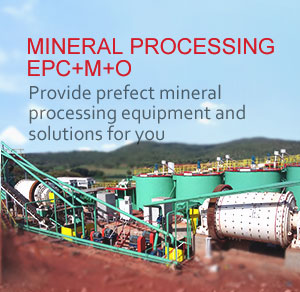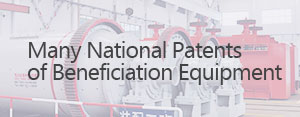The dry tailings disposal system – also called drained tailings stacking – is a sustainable technology that has been increasingly adopted in modern mining plants. Instead of accumulating slurry in large dams, we aim to concentrate solids and return most of the water to the production process. At Xinhai, we consider this technology essential to promote cleaner, safer and more efficient mining. Below, we will introduce the processes related to dry tailings discharge, the equipment involved and real cases from Xinhai.
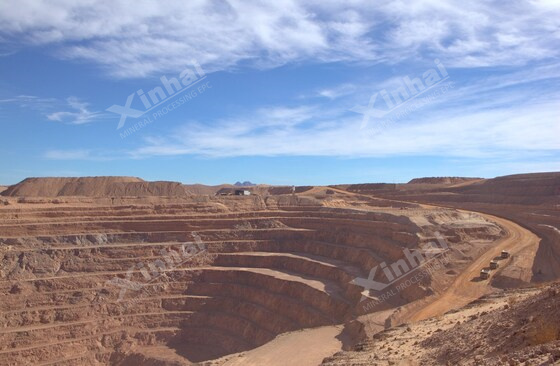
Technical process of Dry Tailings Discharge System
1. High-efficiency thickening
The first step consists of using a high-efficiency thickener. This equipment allows rapid sedimentation of the solids present in the tailings pulp. Thanks to its deep conical design and optimized chemical flocculants, the thickener can significantly increase the solids content, typically from 15–20% to 40–60%. This reduces the volume of free water and prepares the pulp for the next separation stage.
2. Hydrocyclone Classification
After thickening, the rejects are directed to a set of hydrocyclones. These devices use centrifugal force to separate fine particles from the water and coarser particles, which allows the performance of subsequent dewatering equipment to be optimized. The coarse fraction can be sent directly to screening, while the fine fraction is often reprocessed.
3. Dewatering with High Frequency Vibrating Screens
The partially concentrated rejects are then sent to high frequency vibrating screens, which act to remove excess surface water. These screens are capable of handling large volumes and have very fine meshes that favor water flow while retaining solids. This process further reduces moisture and improves the uniformity of the material.
4. Filter Press Filtration
The final and most critical step is performed by filter presses (plate and frame or automatic). These devices use hydraulic pressure to force water through filter fabrics, leaving the solids retained in the form of “dry cakes”. At the end of this process, the rejects reach moisture levels below 20% — in some cases, below 15%, depending on the type of ore and the grain size of the material.
5. Stacking and Dry Storage
The dry rejects are transported to designated areas by belts or trucks. Since they are practically free of free water, they can be stacked in a stable manner, without the risk of liquefaction or rupture, eliminating the need for conventional dams.
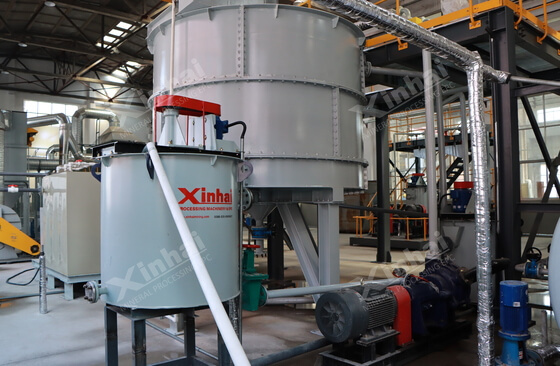
Main Equipment for the Dry Tailings Discharge System
The dry waste disposal process occurs in several stages, each of which requires specialized equipment to ensure maximum efficiency in reducing moisture. Initially, the waste from the mineral beneficiation process is directed to a high-efficiency thickener. This unit's initial function is to separate the solid and liquid fractions by sedimentation, significantly increasing the solids content of the pulp. The concentrated pulp is then pumped to hydrocyclones, which perform an additional centrifugal separation, removing coarser particles and facilitating pre-dewatering.
After this stage, the waste is sent to high-frequency vibrating screens, which are responsible for removing excess free water and preparing the material for final filtration. Finally, the waste passes through chamber filter presses or automatic filter presses, which compact and expel residual water, resulting in a material with moisture content of less than 20%. This dry tailings can then be safely and stably stacked in designated areas, without the need for slurry dams.
In our projects, this treatment sequence – thickening, centrifugal separation, vibratory dewatering and filtration – allows us to achieve solids contents above 85% and water recovery rates above 90%. The recovered water is recycled directly into the process, significantly reducing water consumption and operating costs for our customers.
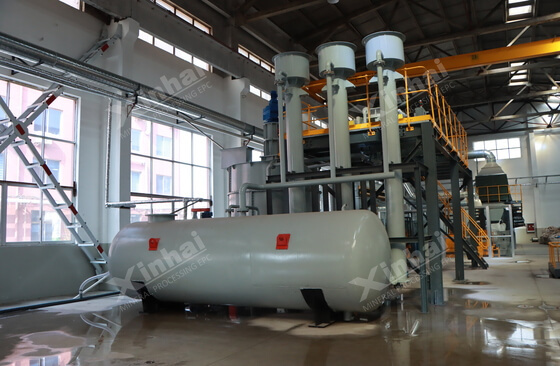
Real Case Studies: Real Dry Disposal Projects Carried Out by Xinhai
1. Iron Ore Dry Tailings Discharge Project – Sichuan, China
Project Context: An iron ore beneficiation plant located in Sichuan had a capacity of 3,560 tons per day. The region experienced seasonal water shortages, which made water reuse a priority to ensure production continuity. Process and Equipment Used: The solution adopted included high-efficiency thickeners model NZS, high-precision cyclones, vibrating screens GPS dewatering systems and XAMY automatic filter presses. The entire system was integrated with abrasion-resistant pumps and intelligent automatic control.
Expected Results: The aim was to achieve 85% solids content in the tailings, reduce the volume of wastewater by 80% and recycle at least 6 million m³ of water annually.
Actual Results: After implementation, the solids content exceeded 88%, the final moisture content was below 16%, and the volume of recycled water reached 6.4 million m³/year. The operation became more sustainable and reduced water collection costs by 65%.
2. Silver-Manganese Dry Tailings Discharge Plant – Inner Mongolia
Project Context: The plant faced challenges due to the complex type of ore, with fine particles and high viscosity. The plant capacity was 2,000 tons per day, and the tailings contained valuable trace metals. Process and Equipment Used: To handle the complexity of the material, an NGZ type deep cone thickener, a two-stage classification system with cyclones and high-frequency screens, and an automatic high-pressure membrane filter press were used.
Expected Results: The aim was to increase the degree of recovery of residual silver and improve dewatering capacity without compromising production.
Actual Results: The moisture content of the tailings was reduced to 17.5%, with additional recovery of up to 3.2% of residual silver. Water recovery reached 91%, and the plant saw a 28% reduction in disposal costs.
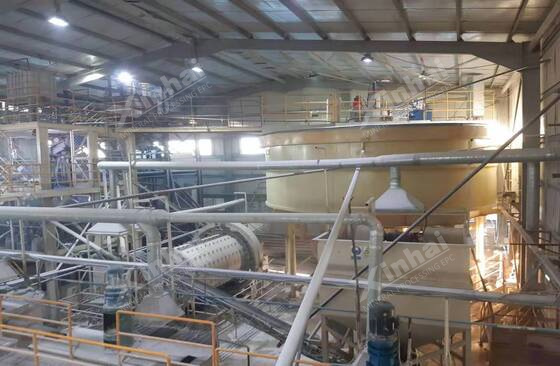
3. Copper Dry Tailings Discharge Project – Pakistan
Project Context: Located in a mountainous area with difficult logistical access, the 1,500 t/d copper project required a low-water consumption and low-maintenance solution.
Process and Equipment Used: A modular system was implemented with a centralized NZS thickener, high-density cyclone, double-layer vibrating screen and XMY automatic plate filter press. The system was designed to facilitate transportation and rapid installation.
Expected Results: Achieve a final moisture content of less than 20%, ensure continuous operation even with water limitations and obtain high stability in dry tailings.
Actual Results: The solids content reached 86%, with a final moisture content of 17%. The system was operated remotely with a high availability rate (>95%), and allowed a 30% reduction in tailings transportation costs.
4. Lead-Zinc Dry Tailings Discharge Plant – Tibet
Project Context: Located in a region of high altitude and extreme climate, the project faced serious risks of tailings dam failure due to cyclical freezing and thawing.
Process and Equipment Used: The solution involved XNZ type thickeners combined with high pressure plate filter presses. The system included automated control for real-time adjustments according to ambient temperature.
Expected Results: The main objective was to eliminate the need for dams and maintain safe operation in a hostile environment.
Actual Results: The plant achieved a water return of 92%, with a final moisture content of only 15.8%. Dry stack stability was certified for local geotechnical conditions, and operation remained stable throughout the seasonal cycle.
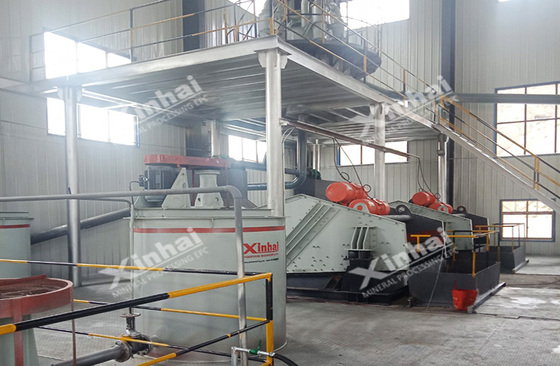
Xinhai’s great advantage lies in our full-service EPCM+O model, which ensures tailored engineering, integration with existing plants, complete equipment supply and global technical support. We work hand-in-hand with our clients at every stage of the project, from mineral testing to installation and ongoing operation.
We believe that dry disposal is an indispensable solution for the future of mining. With our international experience and proprietary technologies, we help our partners achieve environmental goals without compromising their productivity.








 zz540045886@gmail.com
zz540045886@gmail.com Chat
Chat